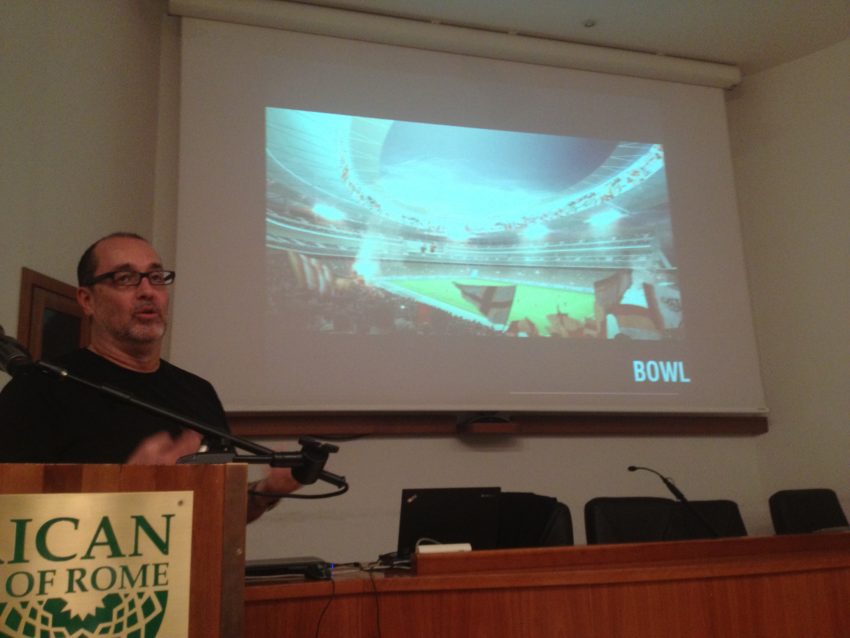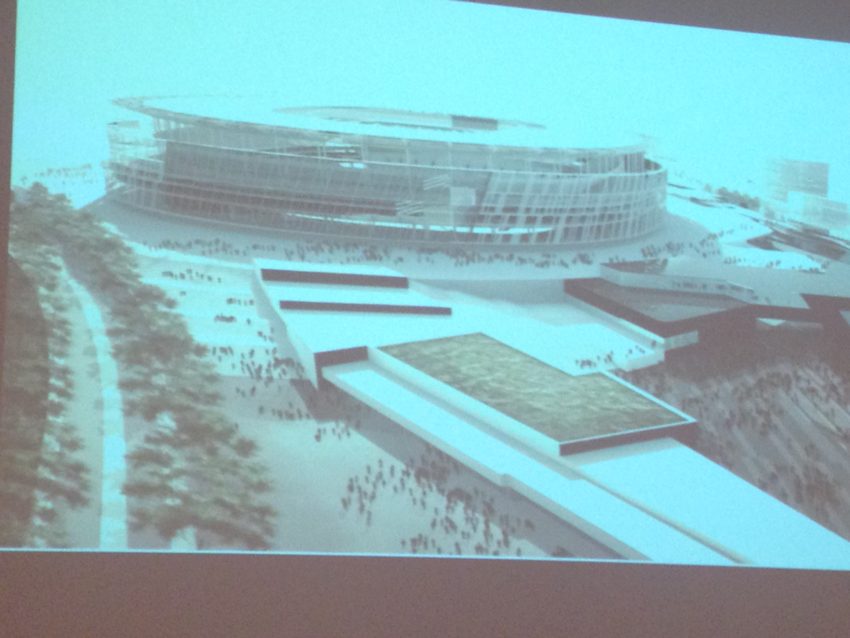New A.S. Roma stadium will combine Ancient Rome with future architecture

FEB. 12, 2015
Rome is nearly 3,000 years old so it’s odd including the word “modernization” in the same discussion. My Apple store is in a mall called Euroma2. Every time I walk in, leaving the ancient, cobblestoned neighborhoods of Rome behind, I feel like I’m entering Disneyland. Or Des Moines. I don’t know which is worse. The modern, chic, New York-style cocktail lounge, Rec23, down the street from my apartment stands out in my old Rome Testaccio neighborhood like a black light poster in the Sistine Chapel.
However, last night I saw Rome all modernized and glittery. And I liked it. A lot. It’s not in the form of a water park or a business center or a god-forsaken mall. It’s a stadium. My beloved A.S. Roma, which started in 1927 and began playing in old Campo Testaccio near my apartment in 1929 and has played in iconic Stadio Olimpico since 1953, is moving into new digs. Stadio della Roma will be the envy of every stadium in Europe. Fans of cross-town Lazio may as well hide their eyes when they drive by it on the way to the beach. It is going to combine the visionary trappings of modern commercialization with features from the Roman Colosseum. Considering the Colosseum was built in 79 AD and the stadium is tentatively scheduled to open in 2016 AD, this project is taking “back to the future” to a level never seen before.
Roma’s players will enter the field by an elevated platform, similar to how gladiators entered the Colosseum. I’m assuming Roma’s opponents won’t be tied to burning pyres or fending off starving lions during warmups. The outside will have windows in similar shape to those in the Colosseum. Fans might travel to games via the Tiber River, a major means of transport during Ancient Rome, minus the rats and filthy gypsy camps.
These ideas seem right off the drawing board of Steven Spielberg or Arthur C. Clarke. In reality, they came from the man who stood in front of me in a packed auditorium at the American University of Rome Wednesday night. Dan Meis should be considered the Frank Lloyd Wright of stadium architects. He not only designed Stadio della Roma but also the Staples Center in Los Angeles, Miller Park in Milwaukee, Paul Brown Stadium in Cleveland and Lincoln Financial Field in Philadelphia among others. He helped renovate Yankee Stadium in New York, RFK Stadium in Washington and Qualcomm Stadium in San Diego. More importantly, he designed Columbus Crew Stadium, the MLS’ first soccer-only stadium. That started a wave of 14 similar stadiums, providing the league with a foundation even rednecks who call soccer “kickball’ can’t dispute.

Meis (pronounced “Meece”) and I have a connection. He’s from Windsor, recently voted the No. 1 city to live in Colorado and 60 miles north of Denver where I worked for The Denver Post for 23 years. He has since moved to New York’s trendy Tribeca neighborhood which tells you how in demand he is. He’s also 53, only five years younger than I am and old enough to remember America’s unsightly cookie-cutter stadiums from the ‘70s. They tried to replicate the Colosseum but instead replicated cracker boxes. They were used for only about 20-30 years, about 400 years less than the Colosseum. I covered baseball and football games in Philadelphia’s Veterans Stadium and Pittsburgh’s Three Rivers Stadium. They had all the character of a 7-Eleven. Once in the Houston Astrodome I saw run across home plate a cat, one of the many employed to keep the stadium’s rat population under control. The fact that the Colosseum also employed members of the feline family is about the only thing it had in common with the Astrodome.
A burly, balding, bearded man with black hair and black glasses, Meis appeared architecturally casual in all black, including black sneakers. Taking this Roma stadium project two years ago got to his heart in a hurry. Six months ago, he had tattooed on the inside of his wrist “SPQR,” Senatus Populusque Romanus, Latin for the Senate and People of Rome. SPQR dates to 80 B.C. and today is still found all over the city. I’m almost that committed. I have in my possession an A.S. Roma sweatshirt, A.S. Roma scarf, A.S. Roma stocking cap, A.S. Roma pennant, A.S. Roma bookmark and A.S. Roma bathrobe. However, I came to Meis’ talk totally neutral. The only item I had was my A.S. Roma keychain.
Of all the stadiums he’s tackled, Meis said Stadio della Roma was “the most challenging.” He’s right. Think about it. How do you project a stadium for the future while including features from a world landmark stadium built just after the time of Christ?
“I couldn’t design a stadium here without thinking about the Colosseum,” Meis said. “This was probably the most frightening thing about this project because if you reference it too much, it can feel like it’s built in Las Vegas. And if you don’t reference it enough it feels a little token.”
Meis also must include the most important feature from Stadio Olimpico: Curva Sud. It’s the area on the south end of the stadium behind the goal which houses the Roma Ultras, the vicious band of fans who turn every game into a war and the stadium into a cauldron. The mob who came to the Colosseum to watch Christians burned alive on long stakes and gladiators behead prisoners of war are still well represented in Curva Sud. In Stadio della Roma, the south end will indeed have a wide curved section for the same fans.
“It’ll almost be like its own venue inside a stadium,” Meis said.
Meis is borrowing a little more of the old with a stairway entrance very similar to the one at the Spanish Steps which is long but wide and not very steep. Famous Roma players will be represented in the Hall of Fame by statues, giving it a true museum feel.
Many of the stadium features, however, will be very new. Behind him, a slideshow showed some of the mad creations he dreamed up. The stadium will be connected to a Roma Village, complete with retail stores and restaurants and caffes (bars in Italian). The club will have a state-of-the-art training facility on the same site. A huge viewing area will be available to watch road games or movie premieres on a giant screen. Party decks will have views of the field and the Tiber River far below.
The stadium will be built from the ground up rather than in a hole. That’s a necessity in Rome since every time you put a shovel into the ground you’re liable to hit a 2,000-year-old temple.
“We joked, ‘Maybe there’s a stadium underneath here,’” Meis said.
It’ll seat 52,500 for soccer, 60,000 for bigger events and seating can be adjusted to as few as 15,000 for an intimate concert. The working budget number is 300 million euros, all provided by private funding and all approved by the city, thanks to the bulldog efforts of American owner James Pallotta.
Afterward, I asked Meis how much credit goes to Pallotta who received approval from a city where opening a small business can be as treacherous as opening a mob boss’ car trunk.
“This isn’t an owner coming in just trying to make money,” he said. “This is somebody who’s investing in the future of the city and the club.”
The timing couldn’t be more perfect. A.S. Roma’s future is bright. It’s in second place for the second straight year and an influx of funds from a new stadium could get it over the hump into Europe’s elite. My big question is ticket costs. While Curva Sud is packed three hours before kickoff, many reserve seats remain empty. Romans are having a hard enough time making ends meet, let alone paying 50 euros for a ticket. If Pallotta is counting on higher ticket prices to help defray costs, this whole thing might backfire.
But Romans are, despite the richest history of any civilization, into the latest trends. A new stadium that glistens like a glass of Prosecco along the Tiber will certainly quench their thirst. If nothing else, it’ll finally replace the Colosseum as the most beautiful landmark in the city.
Now let’s see it last 400 years.

